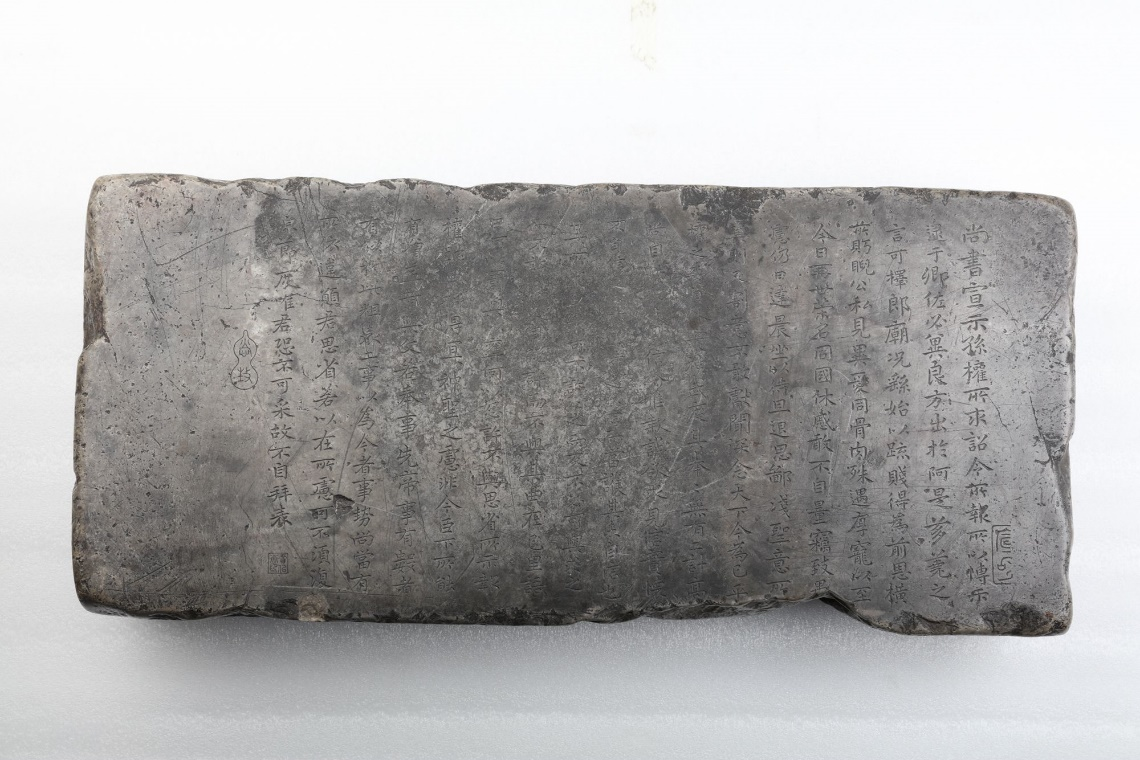Original Stele Inscribed with the Memorial on Announcement Commanded by Jia Sidao-The Capital Museum

Southern Song Dynasty (1127-1279)
24.4 cm in height, 62.5 cm in width and 11.3 cm in thickness
Xuan Shi Biao, or the Memorial on Announcement, refers to the official memorial submitted by Zhong Yao (151-230), a chancellor of the kingdom of Wei in the Three Kingdoms period, to Cao Pi (187-226), first emperor of Wei. Zhong Yao wrote the Memorial to persuade Cao Pi to accept the pledge of allegiance of Sun Quan (182-252), founder of the kingdom of Eastern Wu. The original work of the Memorial was lost during the reign of Emperor Mu (343-361) of the Eastern Jin Dynasty. The copy of the Memorial passed down to this day is, in fact is the version written by calligrapher Wang Xizhi (303-361) of the Western Jin Dynasty imitating the original work of Zhong Yao.
This piece of work was thus named because it is the original stele into which Jia Sidao (1213-1275), prime minister of the Southern Song Dynasty, commanded artisans to inscribe Wang Xizhi's calligraphy of Zhong Yao's Memorial of Announcement. The stele was inscribed on the right side of the first line of the calligraphy with "Xizhi imitated Zhong Yao's calligraphy" written by Zhao Ji, Emperor Huizong of the Song Dynasty (1082-1135) on its frontage with a cross-page seal with Chinese characters "Xuan He" (Emperor Huizong's era name, from 1119-1125) on its surface, with the seal with four Chinese characters "Jia Si Dao Yin" (meaning "Sealed by Jia Sidao") in seal script, and with a calabash-shaped seal with Chinese characters "Yue Sheng" (Yuesheng is the alternative name of Jia Sidao) also in seal script.
After Jia Sidao's death, the original stele inscribed with the Memorial of Announcement was buried deep underground and it was only unearthed in the late Ming Dynasty from the site of Banxian Cottage of the Jia Family in Hill Ge, Hangzhou. Since then, the stele was collected by curio hunters one after another. The back side of the stele carries an inscription with a preface and a postscript written by Jin Nong (1687-1763), a popular painter and calligrapher of the Qing Dynasty. On the surface of the auxiliary stele to the original one there are seals and signets of collectors and connoisseurs or prefaces and postscripts written by them.
The stele is the only surviving one among all that inscribed with the Memorial on the Announcement in the Song Dynasty. The original and authentic writing by Zhong Yao had long been lost, nor could the Wang Xizhi's imitation be found. The only surviving version through a thousand years of history is the original stele.
Compared to other works of Zhong Yao, the Memorial of Announcement represents a more mature style of regular script (kaishu). In terms of calligraphy technique, every stroke is powerful and vigorous. In terms of structure, the characters are simple, but decorous. In terms of style, Zhong Yao's characters are broad and rectangular. All these reflect the fact that calligraphy in Wei and Jin dynasties was assuming a more mature artistic style of regular script, laying the foundation for the thriving of regular script in the Tang Dynasty. Therefore, Zhong Yao's Memorial of Announcement lives up to its reputation of the originator of the regular script art in Chinese calligraphy history.
